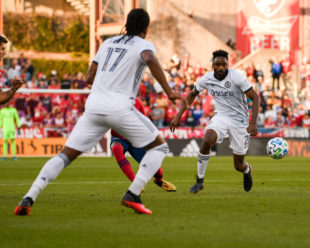Photo by Marjorie Elzey
Lucas Zelarayan, the Argentinian attacking midfielder who will make Columbus, Ohio his temporary home, for more than $7 million.
Matias Pellegrini and his fellow Argentinian, Julian Carranza, who will learn the difference between Fort Lauderdale and Miami for the next few years, all for a combined $14 million or so.
$10 million or so for Alan Pulido, who will find Kansas City a different place than Guadalajara.
… and perhaps you’ve heard of Chicharito?
This is an incomplete but already impressive list of new players who have begun plying their trades on domestic shores this season. Teams are investing at the tops of their rosters with real talent in hopes of that player adding just enough to push their respective teams over the top.
It’s fun for the league and certainly good publicity. The problem with this strategy is evidence suggests this is the worst way to build a soccer team.
Building from the top?
Ask yourself this question:
If you were going to build a basketball team tomorrow with no strings attached (any player from any era for any price), who would you choose first?
This is the kind of question that keeps most sports radio stations in business, but in all honestly the list is probably fewer than 10 players long, including the likes of Kobe (R.I.P.), Lebron, Michael, Larry, Wilt, Russell, Magic, and a few more.
Ask the same question to yourself, but this time with a soccer team.
One suspects the reader could spend a lifetime trying to come up with a final answer, with the short list of all-time greats being probably 50 players long instead of 10.
Sure soccer is a global game with all types of systems, strategies, eras, etc… but so is basketball to be honest. Why, then, is the list for one sport so obvious to compile compared to a list for the other?
Because of the idea of weak links and strong links.
Ties that bind
What are strong and weak links?
Strong: A strong tie is someone who you know well. You’ve probably got their number on your phone. You interact with them on social networking sites. There is good 2 way conversation, and even if you don’t know everything about them, you know them pretty well and information flows freely. We know the same information.
Weak: A weak tie is a more tenuous relationship. Once a year, you may send them a Christmas message promising to be in touch more often. If you look up their number, they are surprised to hear from you. You have different interests and don’t interact much. You might have kept their business card in case it comes in handy one day.
Applying this idea to sports is novel, and was floated by David Sally and Chris Anderson, author’s of The Number’s Game and guests on Malcom Gladwell’s Revisionist History podcast.
Their position is this.
Strong: A sport that is dominated by strong links is one in which a single player has an out-sized affect on an entire team’s success. The nature of such a sport is one in which a single player can affect a higher percentage of his or her team’s plays/outcomes/scores and can conceivably do so with less support from his or her teammates.
Weak: A sport that is dominated by weak links is one in which multiple players are required to be involved in the success of any team’s plays/outcomes/scores. The metaphorical center of gravity of the team, the amount of interplay between team members required for success, outweighs the contributions of any single player.
Strong links
Basketball is a strong links sport.
Adding the best player to any rough equivalent gathering of 4 teammates immediately makes said team significantly better. Why?
That great player can all but “guarantee, or virtually guarantee, that he could get the ball… go to the back court, pick up the ball,… dribble it forward,… break double teams,… and get a shot.”
LeBron James’s addition to the Cleveland Cavaliers in 2003 is a great example. The Rookie of the Year that year, James nearly doubled the team’s win total with an otherwise mediocre roster. The following year, the team were another 30% better and another 20% percent on top the year after, with only minor quality changes in personnel. The Cavs made the NBA Finals in James’s 4th year with what was arguably the worst Finals starting lineup (excluding James) in league history.
James of course left and then returned to Cleveland for a second go-around, taking a 33-win team that missed the playoffs and making it into one that went to 4 straight NBA Finals.
When James left again, the team went from a 50-win juggernaut to a 13-win lottery squad.
One player made all the difference in a line up that was otherwise “relegation-worthy” on two separate occasions.
Strong.
Weak links
Soccer is a weak links sport.
Because soccer is a sport where everyone on the field depends on everyone else,… [and] where if you get a single goal, if you just happen to be lucky, that goal may hold up,… [the worst] player can make one mistake and completely negate the skill of the best player.
The more impactful addition comes from upgrading the team’s worst player. The chance that the worst player will make a mistake that negates the efforts of the group goes down when that player is better, and the chance goes up that the multi-passing miracle that is a goal in soccer actually takes.
Think about the Union.
When most fans are asked how to make the team better, they focus on replacing their perceived “worst” player.
If the Union had a right back that could contribute to the offense… If only the team’s 6 could actually play some defense… If they had a real #10…
This is instinctual for people who love the game and of course correct. No person answers this rhetorical that the team ought to replace Ilsinho with another creative player who is slightly better, or try and find Jamiro Monteiro’s slightly more expensive midfield clone.
That’s nonsense. In a weak links sport, the rising tide is the important effort, not the tallest wave.
Successes and failures
A great example of a failed strong tie addition in soccer is LA Galaxy’s signing of Zlatan Ibrahimovic in 2018.
Following an atrocious 2017 campaign in which the Gals were last in the league on points, the addition of the Lion added 16 points to their final season tally… or 4 fewer than in 2016 and below their 10 year running average (52.5). They also missed the playoffs.
The following year saw somewhat improved success, but a clear and obvious gap between the one-dimensional side and all other true Cup contenders. Carlos Vela scored more goals than any player in league history including Ibrahimovic, but the latter contributed nearly 52% of his team’s goals vs. Vela’s 40%.
The strong link player wasn’t enough to overcome other roster deficiencies.
A possible example of a failed weak link roster in basketball could be the current iteration of the Philadelphia 76ers. 2020 was supposed to the year that this team finally put all the pieces together. Instead, if feels more like a situation in which the team’s great players just aren’t quite great enough.
The team would be unequivocally better if tomorrow they added whomever the reader believes to be the best player in the league, at any position.
Summary
In basketball, one player can make an entire team into a legacy.
In soccer, this run from Maradona and its twin from fellow Argentinian Lionel Messi notwithstanding, the impact any single player can have is substantially lower.
A lot of teams in MLS have added their proverbial “LeBrons” during the 2019/2020 offseason, investing in the top of their rosters with gusto. Many of these players have already added highlight-worthy tallies to their account in the season’s first weekend. By season’s end however, it’s unlikely that one player alone will have a marked impact on the team’s success unless they also raise the level of the players at the bottom of their roster as well.
That’s the simple truth of a weak ties sport.


This is why we need our next DP to be an assist factory.
.
Dockal is a good example of bringing in someone who can help make the team work smoother, and everyone around him better – as compared to a Zlatan who only makes everyone’s passes to him look better.
Absolutely. You need a play-maker who can get service to Santos and Przybylko.
Who knew PSP was important enough to attract Russian trolls? Guess someone forgot the Google translate button.
What can I say – we are a popular site.
What I find interesting is that hockey, which is basically soccer on speed (or soccer is hockey on valium) is a strong link sport and has even fewer players than basketball where you would choose to base a franchise around – #99, #9, #66, and #4. This despite the fact that everyone except the goalies plays less than 50% of the game.
While I’m quite sure a hockey “draft” of this nature would have Gretzky going 1st overall followed by Mario and Howe (in either order) 2 and 3, if I had the 4th “pick” in that draft, there are a few players I’d consider – with Bobby Orr one of them. I’d also give really strong consideration to Martin Brodeur, Patrick Roy, Jaromir Jagr, and Alex Ovechkin. And probably a handful of others depending on some factors. *shrug*
I disagree with your premise Chris, and I think you are underplaying some key issues in your comparison. First, A footy team has more than twice the amount of players participating than basketball does. Second basketball is hardly a world sport. It’s definitely more of a world sport than American football, but not nearly on the same scale as soccer. So the discussion about who you would start a team around and how small the numbers are for basketball vs. the larger pool of soccer players, and thus the impact they make is a bit off base or misguided.
.
As you say, taking the Sixers as an example, even with 3 “superstar” players, they weren’t able to win a title. They tanked for years trying to get that next “superstar” and what has it actually gotten them? Pretty much where they would have been had they continued on from their pre-tank playoff and not tried to tank. So basically losing 3-4 years of playoff basketball without any real headway being made. Inversely, as said above, if this team has or if last year they had Dockal, I believe they would have been much, much better off. Most likely with a better record and a deeper playoff run. I’d also argue it’s easier to hide your weakest link on a soccer team than it is on basketball team.